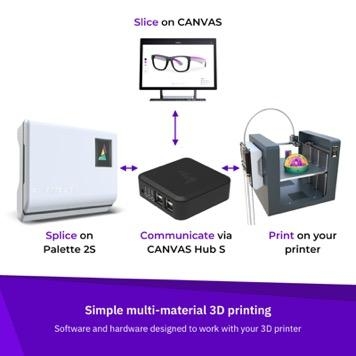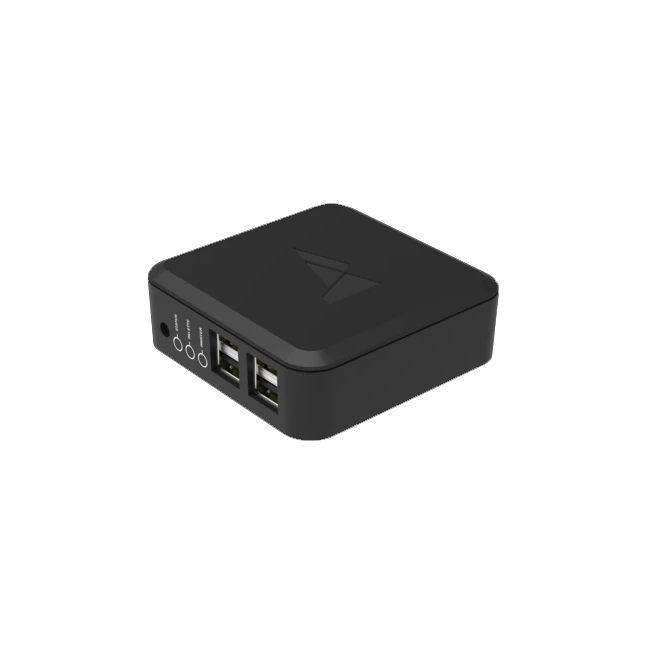Mosaic CANVAS Hub S
CANVAS Hub S - Powering your connected experience
Allows Palette 2 to communicate digitally with your printer and your computer. This communication leads to better calibration, more reliable printing, and a wireless link to the CANVAS platform.
With the launch of CANVAS Hub in 2018, Mosaic took their first step towards creating the connection points for all products in your Palette printing experience. CANVAS Hub allows your printer to communicate with your Palette, giving you the most reliable and simplest multi-material printing experience possible.
Mosaic upgraded the brain inside of CANVAS Hub to give you a faster, more reliable experience than ever before. Since the launch of the original CANVAS Hub, the software has received significant improvements to give you additional control and information from your printing setup.
Connected Printing with Palette
CANVAS Hub S serves four primary purposes:
With the new CANVAS Hub S, mosaic upgraded the hardware inside from a Raspberry Pi Zero, to a Raspberry Pi Compute Module3+
This decision was based on feedback from a number of users who wanted more power and speed on the Hub processor. This upgrade will speed up the startup time of your Hub, increase the reliability of your connection, and give you a smoother experience. It is also powerful enough to support new functionality like a webcam for remote print monitoring and Octolapse video recording.
For those of you who aren’t familiar with the original CANVAS Hub, below is a quick overview of why it's important, and what it allows you to do:
CANVAS Hub enables the CANVAS software platform to communicate with your 3D printer and your Palette 2. This means that—with CANVAS Hub—you won’t have to worry about managing files on different SD cards or connecting your printer to your computer with a USB cable.
With CANVAS Hub’s WiFi connectivity and its connection to both your Palette 2 and your 3D printer, you’ll be able to manage your printing workflow wirelessly through the CANVAS web interface and Mosaic’s customized version of OctoPrint.
More specifically, you can use CANVAS Hub to control aspects of your 3D printer and your Palette 2 from your computer: load and unload filament, jog your extruder, and start a multi-material print.
Creating a Connected Palette 2 Experience
By allowing your 3D printer and Palette 2 to communicate, CANVAS Hub provides a Connected Experience that ultimately simplifies your startup process and increases the reliability of your setup.

When CANVAS Hub is running your print, you can operate off a single print file, and begin your print through the online interface or access your CANVAS print files wirelessly using the color touchscreen on your Palette 2.
CANVAS Hub also enables one of the most crucial features in Mosaic’s new product ecosystem: Digital Pinging.
When Palette 2 is used as an accessory (with no CANVAS Hub), it operates off of what we call pings. Each ping is a series of printer movements that Palette 2 can detect in the printer’s extrusion. Palette 2 detects these pings and uses them to deduce how far the printer has progressed through the G-Code file.
This system works well enough. However, extrusion inconsistencies, print head movement, and a number of other factors can cause missed pings. And missed pings can throw Palette 2’s calibration off, leading to incorrect color placement in a print.
By contrast, CANVAS Hub feeds G-Code to your printer and your Palette 2. It passes pings between the two so, instead of waiting for pauses (like in accessory mode), communication is instant. This digital pinging means that Palette 2 never misses a check-in.
The ability to operate off a single print file and digital pinging both ensure that Palette 2 always receives the information it needs to stay calibrated when working in conjunction with CANVAS Hub.
Calibration and user experience are two of the most important contributors to an enjoyable and painless Palette 2 experience. CANVAS Hub significantly improves upon both of these areas, enabling you to get the most out of your printer setup.
Loaded with New Features That Enhance Your Experience
The seamless connection between Palette, your printer, and CANVAS unlock a variety of other features only possible when the systems are talking to each other.
One of these features is the ability to substantially increase multi-color print speed using the “slow printer during splicing” feature in CANVAS Hub S. This feature will coordinate the printing speed with Palette so that the printer can print at max speed most of the time and only slow down during the moments when Palette is splicing filament (the slowed part of the process). This usually leads to an increase of print speed that is between 20% - 100%.
If you plug a webcam into your CANVAS Hub S, the Pi 3+ Compute Module is now powerful enough to stream live video while it takes care of all the other printing functionality. This means that you can monitor your prints remotely giving you the freedom to leave your printers running with confidence as you work on other projects. You can even use a camera with CANVAS Hub S to record awesome Octolapses.
The Center of your Multi-Material 3D Printing Experience
By using CANVAS Hub S alongside Palette 2S, you can bring your printers online and access entirely new functionality. As such, mosaic worked to construct and price CANVAS Hub S in a way that makes it accessible to all, and we highly recommend it as a supplement to your Palette 2S for the best possible multi-filament printing experience.
And this is just the beginning! Future plans for CANVAS Hub include auto-correct capabilities for lost calibration, broken splices, and several other common print issues. More on this to come, so keep your eyes open for new announcements about CANVAS Hub.
| Manufacturer | Mosaic |
|---|




